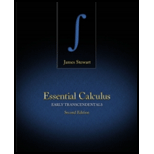
EBK WEBASSIGN FOR STEWART'S ESSENTIAL C
2nd Edition
ISBN: 9781337772198
Author: Stewart
Publisher: VST
expand_more
expand_more
format_list_bulleted
Textbook Question
Chapter T, Problem 6DDT
If
Expert Solution & Answer
Want to see the full answer?
Check out a sample textbook solution
Students have asked these similar questions
a
->
f(x) = f(x) = [x] show that whether f is continuous function or not(by using theorem)
Muslim_maths
Use Green's Theorem to evaluate F. dr, where
F = (√+4y, 2x + √√)
and C consists of the arc of the curve y = 4x - x² from (0,0) to (4,0) and the line segment from (4,0) to
(0,0).
Evaluate
F. dr where F(x, y, z) = (2yz cos(xyz), 2xzcos(xyz), 2xy cos(xyz)) and C is the line
π 1
1
segment starting at the point (8,
'
and ending at the point (3,
2
3'6
Chapter T Solutions
EBK WEBASSIGN FOR STEWART'S ESSENTIAL C
Ch. T - Evaluate each expression without using a...Ch. T - Simplify each expression. Write your answer...Ch. T - Expand and simplify.
3(x + 6) + 4(2x − 5)
(x +...Ch. T - Factor each expression.
4x2 − 25
2x2 + 5x − 12
x3...Ch. T - Simplify the rational expression.
Ch. T - Rationalize the expression and simplify.
(a)
(b)...Ch. T - Rewrite by completing the square.
x2 + x + 1
2x2...Ch. T - Solve the equation. (Find only the real...Ch. T - Solve each inequality. Write your answer using...Ch. T - State whether each equation is true or...
Ch. T - Find an equation for the line that passes through...Ch. T - Prob. 2BDTCh. T - Prob. 3BDTCh. T - Let A(−7, 4) and B(5, −12) be points in the...Ch. T - Sketch the region in the xy-plane defined by the...Ch. T - The graph of a function f is given at the left....Ch. T - If f(x) = x3, evaluate the difference quotient...Ch. T - Find the domain of the function. (a)...Ch. T - How are graphs of the functions obtained from the...Ch. T - Without using a calculator, make a rough sketch of...Ch. T - Let
Evaluate f(−2) and f(1).
Sketch the graph of...Ch. T - Prob. 7CDTCh. T - Prob. 1DDTCh. T - Convert from radians to degrees. (a) 5/6 (b) 2Ch. T - Find the length of an arc of a circle with radius...Ch. T - Find the exact values. (a) tan(/3) (b) sin(7/6)...Ch. T - Express the lengths a and b in the figure in terms...Ch. T - If sinx=13 and secy=54, where x and y lie between...Ch. T - Prove the identities.
tan θ sin θ + cos θ = sec...Ch. T - Find all values of x such that sin 2x = sin x and...Ch. T - Sketch the graph of the function y = 1 + sin 2x...
Knowledge Booster
Learn more about
Need a deep-dive on the concept behind this application? Look no further. Learn more about this topic, calculus and related others by exploring similar questions and additional content below.Similar questions
- I need help in ensuring that I explain it propleryy in the simplifest way as possiblearrow_forwardI need help making sure that I explain this part accutartly.arrow_forwardPlease help me with this question as I want to know how can I perform the partial fraction decompostion on this alebgric equation to find the time-domain of y(t)arrow_forward
- Please help me with this question as I want to know how can I perform the partial fraction on this alebgric equation to find the time-domain of y(t)arrow_forwardEvaluate F³ - dr where ♬ = (4z, -4y, x), and C' is given by (t) = (sin(t), t, cos(t)), 0≤t≤ñ .arrow_forwardMid-Term Review Find the formula for (f + g)(x). f(x) = x² - 10x + 25 and g(x) = x² - 10x + 24 (f + g) (x) = [ 2 ]x² X + DELL Skip Sarrow_forward
- Calculus III May I please have some elaborations on Example 2 part a? Thank you.arrow_forward1. A bicyclist is riding their bike along the Chicago Lakefront Trail. The velocity (in feet per second) of the bicyclist is recorded below. Use (a) Simpson's Rule, and (b) the Trapezoidal Rule to estimate the total distance the bicyclist traveled during the 8-second period. t 0 2 4 6 8 V 10 15 12 10 16 2. Find the midpoint rule approximation for (a) n = 4 +5 x²dx using n subintervals. 1° 2 (b) n = 8 36 32 28 36 32 28 24 24 20 20 16 16 12 8- 4 1 2 3 4 5 6 12 8 4 1 2 3 4 5 6arrow_forward= 5 37 A 4 8 0.5 06 9arrow_forward
arrow_back_ios
SEE MORE QUESTIONS
arrow_forward_ios
Recommended textbooks for you
- Algebra & Trigonometry with Analytic GeometryAlgebraISBN:9781133382119Author:SwokowskiPublisher:Cengage
 Trigonometry (MindTap Course List)TrigonometryISBN:9781337278461Author:Ron LarsonPublisher:Cengage Learning
Trigonometry (MindTap Course List)TrigonometryISBN:9781337278461Author:Ron LarsonPublisher:Cengage Learning Trigonometry (MindTap Course List)TrigonometryISBN:9781305652224Author:Charles P. McKeague, Mark D. TurnerPublisher:Cengage Learning
Trigonometry (MindTap Course List)TrigonometryISBN:9781305652224Author:Charles P. McKeague, Mark D. TurnerPublisher:Cengage Learning  Algebra and Trigonometry (MindTap Course List)AlgebraISBN:9781305071742Author:James Stewart, Lothar Redlin, Saleem WatsonPublisher:Cengage Learning
Algebra and Trigonometry (MindTap Course List)AlgebraISBN:9781305071742Author:James Stewart, Lothar Redlin, Saleem WatsonPublisher:Cengage Learning Mathematics For Machine TechnologyAdvanced MathISBN:9781337798310Author:Peterson, John.Publisher:Cengage Learning,
Mathematics For Machine TechnologyAdvanced MathISBN:9781337798310Author:Peterson, John.Publisher:Cengage Learning, Linear Algebra: A Modern IntroductionAlgebraISBN:9781285463247Author:David PoolePublisher:Cengage Learning
Linear Algebra: A Modern IntroductionAlgebraISBN:9781285463247Author:David PoolePublisher:Cengage Learning

Algebra & Trigonometry with Analytic Geometry
Algebra
ISBN:9781133382119
Author:Swokowski
Publisher:Cengage

Trigonometry (MindTap Course List)
Trigonometry
ISBN:9781337278461
Author:Ron Larson
Publisher:Cengage Learning

Trigonometry (MindTap Course List)
Trigonometry
ISBN:9781305652224
Author:Charles P. McKeague, Mark D. Turner
Publisher:Cengage Learning

Algebra and Trigonometry (MindTap Course List)
Algebra
ISBN:9781305071742
Author:James Stewart, Lothar Redlin, Saleem Watson
Publisher:Cengage Learning

Mathematics For Machine Technology
Advanced Math
ISBN:9781337798310
Author:Peterson, John.
Publisher:Cengage Learning,

Linear Algebra: A Modern Introduction
Algebra
ISBN:9781285463247
Author:David Poole
Publisher:Cengage Learning
Chain Rule dy:dx = dy:du*du:dx; Author: Robert Cappetta;https://www.youtube.com/watch?v=IUYniALwbHs;License: Standard YouTube License, CC-BY
CHAIN RULE Part 1; Author: Btech Maths Hub;https://www.youtube.com/watch?v=TIAw6AJ_5Po;License: Standard YouTube License, CC-BY